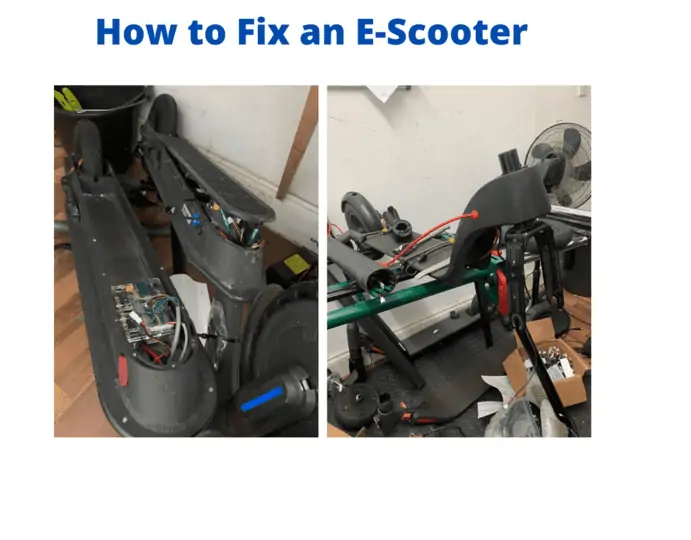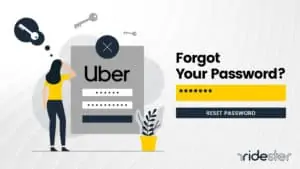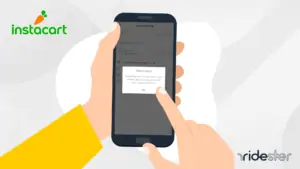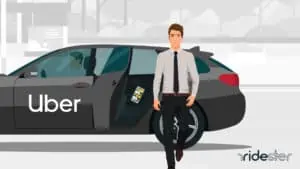I have been riding electric scooters since early 2019.
Unlike today, where there are resources to provide e-scooter maintenance tips, the information at that time was scanty and rare.
I used to maintain my electric scooter perfectly until January 2022 when it had a series of problems.
How to fix an electric scooter like a pro? It’s the question I added to my search browser but unfortunately, I didn’t find any workable solutions.
Now, let’s review real and actionable ways in how you can fix your e-scooter and get it into a perfect working condition.
- Inspect the scooter first
- Summary: Fixing Common Electric Scooter Problems
- 11 Common e-scooter problems and their ultimate fixes
- 1. Electric scooter turns on well but won’t go
- 2. One motor doesn’t work
- 3. Flat tires
- 4. Electric Scooter is not Charging
- 5. E-scooter throttle not working
- 6. Overheating
- 7. Wobbling
- 8. Problematic brakes
- 9. Rear fenders breaking
- 10. Loose screws
- 11. Electric Scooter doesn’t Accelerate
- In Conclusion: How to fix an electric scooter
Inspect the scooter first
You can’t fix something when you don’t know what exactly the problem is, right?
The same applies to when you want to fix an electric scooter.
Some modern electric scooters actually come with an Application to scan any problems the scooter could be having.
A good example is the budget EVOLV Stride electric scooter.
Along with buying the scooter, you also have a mobile App at your disposal.
This app not only shows the range, top speed, battery status, and engaged speed mode but also offers you a quick diagnosis of the scooter to help you know if there are anomalies to be corrected.
If you have an e-scooter that doesn’t feature a diagnosis application, you can as well examine the scooter by using your sense of smell, sight, and touch.
For example, the smell of burnt-out components could indicate a fried controller or other electric components.
So, how do you go about fixing the problems you may have with your e-scooter after determining the problem?
Summary: Fixing Common Electric Scooter Problems
| Problem | How to Fix |
| Electric scooter switched on; doesn’t go | 1. Charge the scooter 2. Tune the brakes 3. Ensure that all the components are properly connected4. Kickstart it |
| Only one motor works | 1. Test if the controllers work fine. If faulty, replace it 2. Change the motor |
| Wobbling | 1. Tighten the bolts and screws 2. Install a steering damper on the stem |
| Flat tires | Seal them with a slime sealant |
| Scooter doesn’t charge | 1. Change the charger 2. Change the Battery Management System3. Change the battery |
| Throttle doesn’t work | Replace it |
| Overheating | 1. Turn off the electronic braking 2. Use a scooter heatsink |
| Brakes failure | Switch to hydraulic brakes |
11 Common e-scooter problems and their ultimate fixes
Under most and normal circumstances, a well-maintained electric scooter won’t require repair as a whole but some components.
This is to tell you fixing one or a few components will solve the problems the scooter may have and get back to doing what you love the most -riding.
Below, let’s review several problems and how you can fix them to keep your electric scooter running in perfect shape.
1. Electric scooter turns on well but won’t go
Does your e-scooter turn on perfectly but doesn’t go no matter what you do? Well, it’s a common problem, and troubleshooting it is simple.
Since electric scooters are manufactured differently, there are many reasons why the scooter can turn on perfectly but stay still.
One of the most common ones is low voltage.
It’s important for you to note that without sufficient voltage, the motor won’t spin.
While the scooter may turn on as expected, the scooter won’t move an inch when the battery is below the bare minimum or if the cut-off has been reached.
To solve this, ensure that the battery is fully charged.
Having full voltage going to the motor will most definitely fix an electric scooter that doesn’t go after turning on.
The other common reason is that the brakes may need to be adjusted properly.
Poorly-adjusted brakes usually end up making the tires fail to spin as expected and this would mean the scooter won’t go.
To know if the brakes are engaged, some models such as YUME Y10 show an exclamation mark on the display.
Readjusting them as per the manual fixes this common electric scooter problem.
Again, if there are primary faulty or loose electric components such as wires and connectors from the controllers, then the scooter may also fail to run.
You may need to open the deck and keenly look into these.
If you aren’t handy enough, you may need to take your scooter to a repair shop for fine-tuning.
Lastly, your scooter may need to be jumpstarted.
Some models such as the Razor E100 model start well when they are jumpstarted.
To fix this, ensure that you kickstart the scooter and only work with the throttle after you hit a speed of more than 2 miles per hour.Â
RECOMMENDED: Troubleshooting different electric scooter parts’ problems.
2. One motor doesn’t work
If your electric scooter features dual motors and for some reason, one doesn’t work even when you are in a dual-motor mode, then you aren’t alone.
It’s a common problem we have seen for a long time and one of the key causes is a fried controller.
If the motors have the same capacity (for instance, 1200W rear and 1200W front), then we recommend that you switch the controllers and see if the other works.
If it works, then know that it was a case of a burnt-out controller.
We don’t recommend riding a dual-motor electric scooter in a single-motor mode and as such, we recommend that you replace the faulty controller as fast as possible.
Riding with a single motor is a sure path towards straining that motor and damaging the other controller, or in the worst case scenario destroying the motors completely.
If the motor doesn’t work even after swapping out the controllers, then that motor could be damaged probably due to moisture or burning out.
To fix such a problem, you have no choice but to replace or repair the damaged motor.
In the event that the motors don’t have the same capacity, then your best way to test the faulty one is by taking it to a repair shop that has an electrical expert.
They are supposed to test the inoperative motor.
If it shows that it’s faulty, then you are supposed to replace it.
If the tests show it’s working, then you may need to change the controller to a functional one.
3. Flat tires
Flat tires suck and unfortunately, you will have to deal with them if your scooter features the pneumatic type.
Of course, this is regardless of whether you own a tubed tire or a tubeless one.
Some manufacturers such as Kaabo have their hyper scooters featuring pneumatic tires with self-healing properties and this is a great innovation.
If your electric scooter features the air-filled tire type, you can fix flat tires with the use of a sealant.
We highly recommend using the Slime tire sealant.
Most tire sealants won’t work well with tire tears, though.
In case of such a scenario, you can visit your nearest electric scooter repair shop for a better solution.
Flats have actually made some e-scooter manufacturers produce electric scooters featuring solid tires or a combination of a solid and air-filled tire to diversify the risk.
You can read the differences between solid and air-filled tires in our blog post.
4. Electric Scooter is not Charging
There are many anomalies that can happen as you try to charge your electric scooter.
The leading cause of an electric scooter failing to charge is a faulty charger.
If your charger is faulty, then you will have to replace it.
A faulty charger will definitely not charge your e-scooter.
We highly recommend that you don’t keep a faulty charger in the power socket since it’s leeway for shocks happening and increasing the chances of causing a fire.
Again, we recommend that you charge your scooter with the original charger.
In case it goes faulty, you may best ask for the retailer to send to you another original one.
While a charger may have the same specifications as another, dealing with the manufacturer for such parts is a great way to prepare for any problems that may appear in the future, especially if the scooter is under a warranty.
The other reason why your scooter may not be charging is due to a faulty battery.
While most batteries can serve you for 3 years and with 500 charging cycles, your riding style, terrains, and riding frequencies determine how long the battery will stay will charging.
If the chargers are working perfectly but the scooter doesn’t charge, then the battery might be faulty.
It’s important for you to remove such a battery from the scooter and replace it with a functional one.
If the Battery Management System (BMS) is dead, some scooter models can fail to charge.
The BMS is responsible for preventing undercharging and overcharging in electric scooters but some scooter models customize it such that once it becomes faulty, charging is impossible.
To fix this, you will have to replace it.
5. E-scooter throttle not working
Most electric scooters and especially those that have thumb throttles sometimes have a dead zone.
With a dead zone, it means that the scooter throttle is not working to the optimal.
To fix such kind of a problem, we found that replacing the throttle is the best and properly only idea.
While you may decide to keep riding with such an accelerator, you will and must notice that with time that the scooter doesn’t run even after flooring it to full throttle.
Replacing an electric scooter throttle with a functional one isn’t a problem with most handy owners.
They ideally need to cut the wires from the controller to the older one and attach them to the new throttle.
If you are doubtful of your skills, though, we recommend that you have your throttle replaced or repaired at the nearest electric scooter repair shop.
6. Overheating
When you push your electric scooter to its limit, there are high chances that it will overheat.
There really is no cause for alarm in this problem as fixing it just involves switching it off and allowing it to cool down before going for a ride.
However, if you were riding in the ECO Mode or just the Standard Mode and the in-hub motor overheated, then there is a problem.
You can fix this by turning off the electronic brake if your scooter has it.
If your scooter doesn’t have that braking type, then making use of a heat sink will help you big time.
We also recommend that you avoid riding when the heat is too much in the summer unless it’s necessary.
That way, your scooter won’t overheat for long.
7. Wobbling
Wobbling, especially for high-speed electric scooters is common.
Some parts known for electric scooter wobbling include the front tires and the stem.
If the front tire wobbles, then it’s an indication of little to no contact between the tire and the riding surface.
To fix this, begin by ensuring that the tire is properly aligned.
Deflating it as you do the alignment makes it easier for you.
After that, ensure that tighten the front motor bolts to sturdiness.
If the stem wobbles, get a high-quality steering damper and install it.
A damper solves 99% of the wobbling problems on the e-scooter.
Lastly, ensure that the screws and bolts are properly tightened.
Some e-scooters have bolts beneath the folding mechanism and unless you tighten them as expected, your scooter wobble problem will be present.
8. Problematic brakes
Electric scooter brakes, especially the mechanical type are known to be very problematic.
While you may replace them, it’s not worth it in the long term.
In any case, you deserve longevity and reliability when it comes to brakes as they are the most important safety feature.
We find that switching your mechanical brakes to the hydraulic type is the best idea if you consider longevity and efficiency.
In fact, if you were looking forward to owning an electric scooter that comes with the hydraulic brake type, we have compiled a list of just those.
9. Rear fenders breaking
I have replaced over 5 rear fenders since 2019 and I have to agree that most fenders are only made from cheap plastic.
If the rear fender in your scooter feels cheap and of inferior quality, I recommend that you buy a steel rear fender and it will serve you longer.
Some brands such as YUME actually did away with the plastic rear fenders in their top-selling YUME X11 with damper and now sell it with steel fenders.
10. Loose screws
This may appear to be a small problem, but believe that loose screws will mess you up.
Loose screws may end up causing massive wobbles, and these could actually make you get involved in an electric scooter accident.
To fix the problem of the loose screw, ensure that you tighten them at least once a week before you ride.
If you would like to solve this problem for long and especially if you can forget to tighten the screws, you can apply a Blue Loctite thread locker to all the bolts and screws.
Your scooter will be sturdy like a tank.
11. Electric Scooter doesn’t Accelerate
If your electric scooter doesn’t accelerate, then it means there is a problem with the speed controller.
Under normal circumstances, unplugging the speed controller and checking if there are burnt-out wires will be a sure way to enable you to know the problem.
If there are some wires presenting any problems, then you can replace them.
If the problem is that the controller is fried, then you can replace it for better acceleration.
In Conclusion: How to fix an electric scooter
Have you ever found yourself searching how to fix an electric scooter?
Did you find any solution?
Learning how to fix your electric scooter is a powerful skill to possess and also monetize it if need be.
If you are not used to it, we recommend that you take your scooter to the professionals instead.
That way, you will avoid damaging the electric components.






